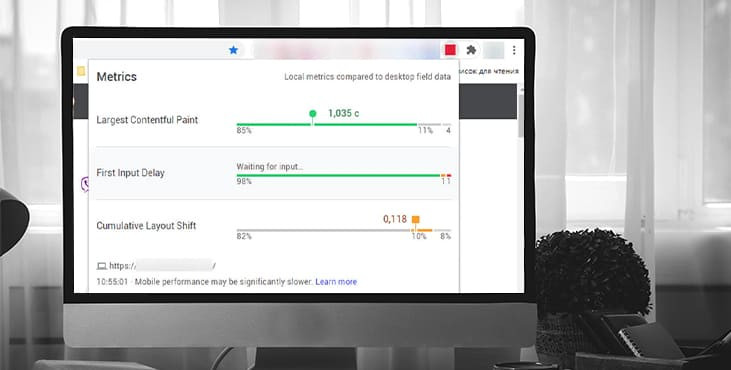
What are Core Web Vitals and how to improve them
To create a comfortable search space for users, Google developers regularly update ranking algorithms. In 2021, another addition of parameters took place, among which the technical indicators of Core Web Vitals began to occupy the most important place. In this article, you will learn what they are and how they can be improved.
What are Core Web Vitals at Google
Core Web Vitals are a group of quantitative parameters aimed at evaluating the technical performance of a site. The metrics included in it analyze the quality of the resource in three areas: the loading time of the page and its elements, interactivity and visual stability of objects. The set of new site evaluation parameters consists of three metrics.
Largest Contentful Paint (LCP) is a metric that evaluates the load time of the main content: videos, images and text. It affects user behavior because it allows you to quickly see the content of the site and start interacting with it.
The LCP score is assigned taking into account the following values:
- more than 4 seconds is not good;
- from 2.5 to 4 seconds is acceptable, but can be improved;
- less than 2.5 seconds is good.
First Input Delay (FID) is the parameter that evaluates the speed with which the interactive elements of the site (buttons, links, etc.) react to interaction with them.
FID rating depending on the results:
- more than 300 m/s is unsatisfactory;
- from 100 to 300 m/s improvement needed;
- less than 100 m / s is excellent.
Cumulative Layout Shift (CLS) is a metric that determines the stability of the page at the time of its loading. It is important because unexpected shifting of elements can annoy users and negatively affect the usability of the site in general.
Influence of the indicator on the page score in terms of CLS:
- more than 0.25 is unsatisfactory;
- from 0.1 to 0.25 improvement needed;
- less than 0.1 is an excellent result.
How Core Web Vitals affects SEO promotion in Google
Page Experience is a new Google algorithm that aims to evaluate sites in terms of their convenience for visitors. When generating the issuance, the main Internet indicators of Core Web Vitals are now taken into account, as well as adaptability, security, unobtrusiveness, and the presence of HTTPS. Of course, in addition to convenience, Google also analyzes other indicators: content quality, compliance with E-A-T principles, behavioral factors, external link profile, etc. But the new LCP, FID, and CLS metrics will now play a significant role in generating SERPs.
How to check Core Web Vitals parameters
Let's look at 4 ways to evaluate LCP, FID and CLS metrics on your site:
1. Google Search Console Reports
The Core Web Metrics report in the Improvements section contains the most complete information about the results of checking the entire web resource. The analysis takes into account user behavior, information about which the system loads from Chrome reports. Here you can also get general information about the existing problems that negatively affect the Core Web Vitals metrics.
2. PageSpeed Insights service
Here, as in the Search Console reports, information is provided on the indicators of different groups of users as stationary and mobile. The source is data from Lighthouse forecasts and user experience in the Chrome browser. The peculiarity of the PageSpeed Insights service is that it suggests how to improve the parameters of Core Web Vitals.
3. Web Vitals Chrome Extension
Special Google Chrome extension. By installing it, you can monitor the current CWV parameters. This is especially convenient when working with codes: online you can see the results of the check in order to commit changes.

4. Chrome DevTools
General information about the Core Web Vitals metrics is available in the Performance panel. This resource will not allow you to find information about errors and required improvements, but it is quite suitable for quick verification and understanding of the situation.
How to improve Core Web Vitals key metrics
There are a number of fairly common issues and bugs that negatively affect Core Web Vitals metrics. To fix them, you need to:
- Get rid of third-party unused scripts. This will help speed up page loading and improve LCP and FID performance.
- Optimize graphical objects by reducing their “weight” or removing them altogether.
- Set up lazy loading functions, in which some elements will not be loaded immediately, but only when the page is scrolled.
- Set up data caching.
- Change web host. Many indicators depend on the quality of hosting, including the speed of downloading and receiving a server response to a user's action.
- Specify the size of the most weighty elements in the settings. The browser will take this data into account and load objects with some delay, leaving certain places for them. The rest of the content will load faster and without offset.
- Set fixed places for ad blocks. So they will not shift the content located in the main part of the page.
The listed optimization tools can positively influence not only the parameters of Core Web Whites, but also some other technical indicators of the site. They can also directly affect behavioral factors that are also important in ranking.
Conclusions
Requirements for the quality of the site in terms of usability are not only related to the relevance of the content or the level of security. User comfort also largely depends on the technical parameters of the web resource. Noting this, Google developers have made changes to the ranking algorithms and supplemented them. Core Web Vitals do not require SEOs to take any new steps to improve the site.
The invention entails elevating the significance of speed indications and improving user convenience when interacting with them. Sites that were qualitatively optimized before the upcoming upgrade to the ranking algorithms do not run the risk of falling in the rankings.
Get an SEO Analysis for your website as a bonus
Tell us what you think
By clicking 'Submit', you agree to Privacy Policy and authorise our staff to contact you. You are liable under the Personal Data Protection Act if you key in false personal data or other people’s personal data.
offers and news
